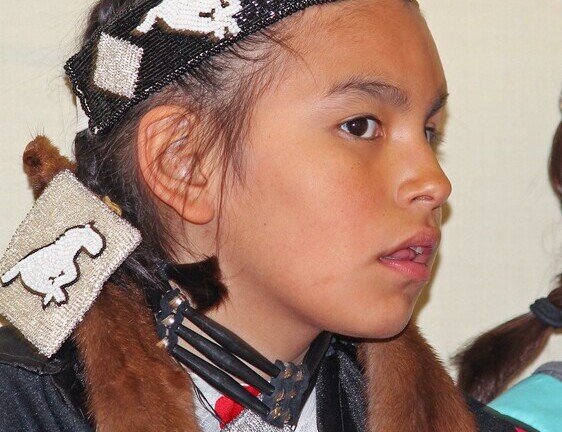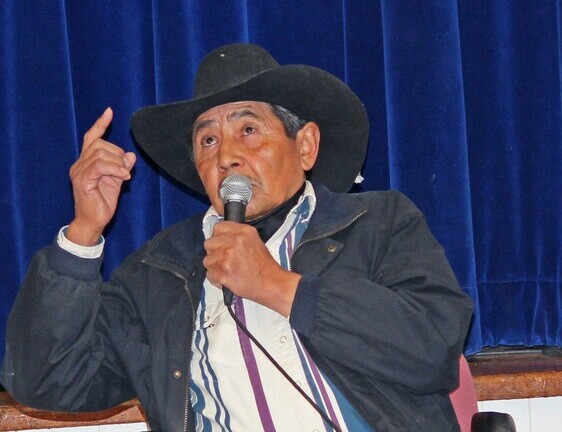
Cultural exchange with Piikani school includes residential school impact
Mark Anderson read aloud a story of a young First Nations student who learned to count to 30 by the number of times her teacher brought the strap down on her outstretched palms. Her sister learned to count to 50.
“Did anyone here learn to count that way?” he asked students from host Sunnyside School, and their guests from his own Napi’s Playground Elementary School on the Piikani Nation.
The two schools have enjoyed a partnership over the years, originating with Anderson’s time as a student teacher in Ken Van Cleave’s classroom at the Palliser school almost a decade ago. He took a job teaching in Brocket and a handful of visits between the two schools would follow.
Past get-togethers have included drum making, cultural scavenger hunts and mini-basketball games. This day-long cultural exchange, however, marked the first time the impact of residential schools on the First Nations community and its culture was included.
This visit was part of Project of Heart, a national program that encourages education and reconciliation among the First Nations and non-native Canadians.
“This isn’t about blame, about getting revenge. It’s about understanding,” Anderson told students. “It affects the children being raised today, so it’s important we remember, and show respect.”
Before they heard from two residential school “survivors,” the host Grade 4 students were asked if they knew the importance of talking about the issue. Several hands shot upwards in reply.
“So it never happens again,” replied a Sunnyside student.
“So we can appreciate what we have today,” added another.
Although a framework of expectations is still under construction, the province has committed to greater First Nations, Metis and Inuit (FNMI) content in the curriculum at all grade levels. Schools have started to address that directive at their own pace, and Palliser Regional Schools’ next collaborative day will include FNMI resources.
Sunnyside’s ongoing relationship with its Piikani friends may place it ahead of the pack. This day not only included first-hand testimonials about residential schools, but dancing, drumming and crafts, and plenty of shared smiles.
“It’s definitely not going to be like classroom learning,” Van Cleave told the Sunnyside School students to kick off the program. “This is going to be an experience, and you don’t forget experiences.”
Sienna Hoffman said learning more about First Nations culture was “super interesting and cool,” and she particularly enjoyed meeting new friends. As for the message she received about residential schools, the Grade 4 student surmised: “I think that we need to treat everyone, like good, so that everyone feels welcome and happy.”
It wasn’t an education for the Sunnyside students alone. Anderson said the residential school experience isn’t something talked about much in the homes of his own students.
“They were punished for speaking Blackfoot, for being Blackfoot. They didn’t want their children to go through that too,” said Anderson, whose wife is the daughter of a residential school survivor. “So they don’t pass their culture on, and they don’t talk about this history because it is a painful thing to bring up.”
Blackfoot Elder Rosaline Crow Shoe told the students she closed the door on her painful memories of residential schools and never talked about them for years.
“I wanted to forget,” said the former Blackfoot and culture teacher at Napi’s Playground, adding she and her classmates learned more about washing floors than math or science. “We were like slaves.”
Students were called by a number appointed them – 17, in her case – and not their given names. Crow Shoe spoke about the incessant sores behind her ears, from being dragged up to the chalkboard for punishment. She had difficulties showing affection to her own children later in life, because cruelty, and not parenting, was modelled at residential school.
Elder Wallace Yellow Face, who opened the program with a traditional Blackfoot prayer and smudge ceremony, told the students about running away from the beatings he received at residential school. He was always brought back, however, as his parents were threatened with jail if he didn’t go to school.
When Yellow Face was caught speaking Blackfoot, he remembers being led into the bathroom and forced to wash his own tongue with soap.
“My language is my identification. It identifies who I am. I’m a Blackfoot,” he said.
Van Cleave, who was brought up to beat the drum for the final dance number, said he hopes Sunnyside students now have a better understanding of the “trials and tribulations” suffered by the aboriginal community at residential schools.
“They can hear these stories and say, ‘we’re the future, and this cannot happen again,’ ” he said.
Anderson hopes students from both schools come away with a common message.
“It’s OK to be different from each other and it’s OK to have different cultures and different backgrounds,” he said, adding Piikani kids like to play video games, wear cool shoes and love basketball and Beyoncé, just like their Sunnyside counterparts. “When they find what connects them, they can appreciate the differences as well.”





